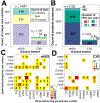Statistical Validation of Rare Complement Variants Provides Insights into the Molecular Basis of Atypical Hemolytic Uremic Syndrome and C3 Glomerulopathy
- PMID: 29500241
- PMCID: PMC6324840
- DOI: 10.4049/jimmunol.1701695
Statistical Validation of Rare Complement Variants Provides Insights into the Molecular Basis of Atypical Hemolytic Uremic Syndrome and C3 Glomerulopathy
Abstract
Atypical hemolytic uremic syndrome (aHUS) and C3 glomerulopathy (C3G) are associated with dysregulation and overactivation of the complement alternative pathway. Typically, gene analysis for aHUS and C3G is undertaken in small patient numbers, yet it is unclear which genes most frequently predispose to aHUS or C3G. Accordingly, we performed a six-center analysis of 610 rare genetic variants in 13 mostly complement genes (CFH, CFI, CD46, C3, CFB, CFHR1, CFHR3, CFHR4, CFHR5, CFP, PLG, DGKE, and THBD) from >3500 patients with aHUS and C3G. We report 371 novel rare variants (RVs) for aHUS and 82 for C3G. Our new interactive Database of Complement Gene Variants was used to extract allele frequency data for these 13 genes using the Exome Aggregation Consortium server as the reference genome. For aHUS, significantly more protein-altering rare variation was found in five genes CFH, CFI, CD46, C3, and DGKE than in the Exome Aggregation Consortium (allele frequency < 0.01%), thus correlating these with aHUS. For C3G, an association was only found for RVs in C3 and the N-terminal C3b-binding or C-terminal nonsurface-associated regions of CFH In conclusion, the RV analyses showed nonrandom distributions over the affected proteins, and different distributions were observed between aHUS and C3G that clarify their phenotypes.
Copyright © 2018 by The American Association of Immunologists, Inc.
Figures






References
-
- Goodship TH, Cook HT, Fakhouri F, Fervenza FC, Frémeaux-Bacchi V, Kavanagh D, Nester CM, Noris M, Pickering MC, Rodríguez de Cordoba S, Roumenina LT, Sethi S, and Smith RJ. 2017. Atypical hemolytic uremic syndrome and C3 glomerulopathy: conclusions from a “Kidney Disease: Improving Global Outcomes” (KDIGO) Controversies Conference. Kidney Int 91: 539–551. - PubMed
-
- Warwicker P, Goodship TH, Donne RL, Pirson Y, Nicholls A, Ward RM, Turnpenny P, and Goodship JA. 1998. Genetic studies into inherited and sporadic hemolytic uremic syndrome. Kidney Int 53: 836–844. - PubMed
-
- Fakhouri F, Zuber J, Frémeaux-Bacchi V, and Loirat C. 2017. Haemolytic uraemic syndrome. Lancet 390: 681–696. - PubMed
-
- Sansbury FH, Cordell HJ, Bingham C, Bromilow G, Nicholls A, Powell R, Shields B, Smyth L, Warwicker P, Strain L, Wilson V, Goodship JA, Goodship TH, and Turnpenny PD. 2014. Factors determining penetrance in familial atypical haemolytic uraemic syndrome. J Med Genet 51: 756–764. - PubMed
Publication types
MeSH terms
Substances
Grants and funding
LinkOut - more resources
Full Text Sources
Other Literature Sources
Miscellaneous

